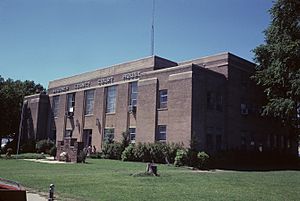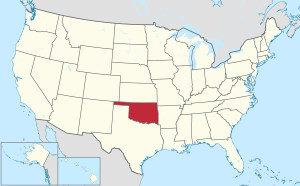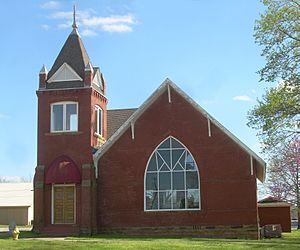Wagoner County, Oklahoma facts for kids
Quick facts for kids
Wagoner County
|
|
|---|---|

Wagoner County Courthouse in Wagoner
|
|

Location within the U.S. state of Oklahoma
|
|
 Oklahoma's location within the U.S. |
|
| Country | |
| State | |
| Founded | 1907 |
| Named for | Henry "Bigfoot" Wagoner |
| Seat | Wagoner |
| Largest city | Coweta |
| Area | |
| • Total | 591 sq mi (1,530 km2) |
| • Land | 562 sq mi (1,460 km2) |
| • Water | 29 sq mi (80 km2) 4.9%% |
| Population
(2020)
|
|
| • Total | 80,981 |
| • Density | 137.02/sq mi (52.91/km2) |
| Time zone | UTC−6 (Central) |
| • Summer (DST) | UTC−5 (CDT) |
| Congressional districts | 1st, 2nd |
Wagoner County is a county in the state of Oklahoma. It's a place where many people live, work, and go to school. In 2020, about 80,981 people called Wagoner County home. The main town, or county seat, is Wagoner.
Wagoner County is also part of the larger Tulsa area, which is a big group of cities and towns connected together.
Contents
History of Wagoner County
Early People and Ancient Builders
Long, long ago, from about 300 to 1200 AD, people known as Caddoan Mound Builders lived in this area. They built large earth mounds, which were often used for ceremonies or as burial sites.
Native American Settlements
Later, in the 1820s, the western part of what is now Wagoner County became home to the Creek tribe. They were forced to move here from their lands in Alabama. The eastern part of the county was settled by the Cherokee tribe.
Wagoner County During the Civil War
During the American Civil War in 1865, a battle called the Battle of Flat Rock happened here. It was also known as the Hay Camp Action. In this battle, Confederate soldiers, led by Generals Stand Watie and Richard Gano, fought against Union troops. The Confederates captured many Union soldiers who were gathering hay.
How Wagoner County Was Formed
Before Oklahoma became a state, there was an idea in 1905 to create two new counties in this area: Coweta and Tumechichee. However, this plan didn't happen because the idea of creating a new state called Sequoyah didn't work out.
When Oklahoma officially became a state in 1907, Wagoner County was finally created. Several towns, like Porter, Coweta, and Wagoner, wanted to be the county seat. Wagoner won the election and became the main town. The county and the town were named after Henry "Bigfoot" Wagoner, who worked for the Katy Railroad.
Geography of Wagoner County
Land and Water
Wagoner County covers about 591 square miles. A small part of this, about 29 square miles, is covered by water. The county is part of the Ozark Highlands, which are rolling hills and plateaus.
Rivers and Lakes
The Verdigris River flows through the county, dividing it into eastern and western parts. The Arkansas River forms some of the county's western and southern edges. The Grand River also flows south through the county. In 1942, a dam was built on the Grand River, creating Fort Gibson Lake, a popular spot for recreation.
Neighboring Counties
Wagoner County shares borders with these other counties:
- Rogers County (to the northwest)
- Mayes County (to the northeast)
- Cherokee County (to the east)
- Muskogee County (to the south)
- Tulsa County (to the west)
Population and People
| Historical population | |||
|---|---|---|---|
| Census | Pop. | %± | |
| 1910 | 22,086 | — | |
| 1920 | 21,371 | −3.2% | |
| 1930 | 22,428 | 4.9% | |
| 1940 | 21,642 | −3.5% | |
| 1950 | 16,741 | −22.6% | |
| 1960 | 15,673 | −6.4% | |
| 1970 | 22,163 | 41.4% | |
| 1980 | 41,801 | 88.6% | |
| 1990 | 47,883 | 14.5% | |
| 2000 | 57,491 | 20.1% | |
| 2010 | 73,085 | 27.1% | |
| 2020 | 80,981 | 10.8% | |
| 2023 (est.) | 89,280 | 22.2% | |
| U.S. Decennial Census 1790-1960 1900-1990 1990-2000 2010-2019 |
|||
Wagoner County has grown quite a bit over the years! In 2010, there were about 73,085 people living here. By 2020, the population had grown to 80,981. People from many different backgrounds live in Wagoner County, making it a diverse place.
Communities in Wagoner County
Wagoner County has several cities and towns where people live. Some of these places are also partly in other counties.
Cities
- Bixby (mostly in Tulsa County)
- Broken Arrow (also in Tulsa County)
- Catoosa (mostly in Rogers County)
- Coweta
- Tulsa (mostly in Tulsa County)
- Wagoner (the county seat)
Towns
- Fair Oaks (also in Rogers County)
- Okay
- Porter
- Redbird
- Tullahassee
Census-Designated Places
These are areas that are like towns but are not officially incorporated as cities or towns.
- Clarksville
- Mallard Bay
- Rocky Point
- Taylor Ferry
- Toppers
- Whitehorn Cove
Education in Wagoner County
There are many school districts in Wagoner County that serve students from kindergarten through 12th grade.
- Bixby Public Schools
- Broken Arrow Public Schools
- Catoosa Public Schools
- Chouteau-Mazie Public Schools
- Coweta Public Schools
- Fort Gibson Public Schools
- Haskell Public Schools
- Inola Public Schools
- Locust Grove Public Schools
- Okay Public Schools
- Porter Consolidated Schools
- Tulsa Public Schools
- Wagoner Public Schools
Historic Places to See
Wagoner County has many interesting places listed on the National Register of Historic Places. These are buildings and sites that are important to the history of the area and the country.
Here are some of the historic places in Wagoner County:
|
|
See also
 In Spanish: Condado de Wagoner para niños
In Spanish: Condado de Wagoner para niños



